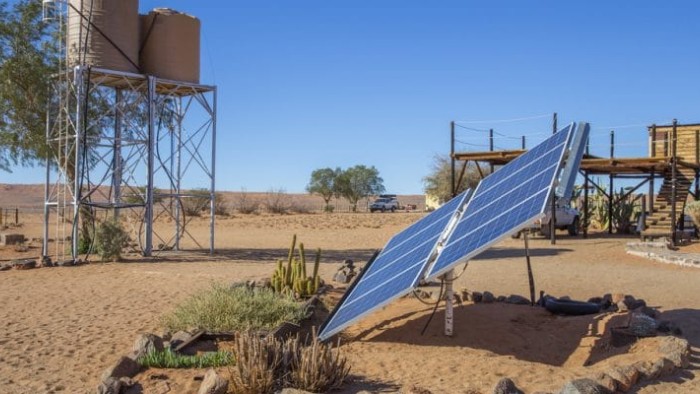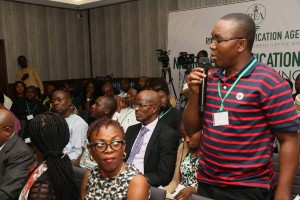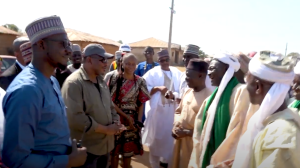Turning Up Clean Power in Nigeria Runs Through Two Paths (First of Two Parts)

In Brief
Mini-grids in rural African communities can mean illuminating households and growing businesses.
Two devices, a grant and a tender, have set international solar developers in search of market share in Nigeria's rural communities.
This first in a two-part report lays out the rationale and main actors in a bid to clean up and spread out rural power for a rapidly urbanizing nation.
The YouTube page run by Nigeria’s Rural Electrification Agency regularly features documentary-style updates on its projects. One such upload presents the December 2019 commissioning ceremony of a solar-powered mini-grid in Rokota, a town in Niger State. Over one hundred people sit in the middle of a large white tent, and many more line the edges. All eyes are on the series of speakers addressing the crowd from behind a glass podium. “We have pulled through the hardest times,” says Damilola Ogunbiyi, the former Managing Director of Nigeria’s Rural Electrification Agency, “to tell people that off-grid is not just nice to have, but it’s actually a good power solution for at least 100 million Nigerians.” Many members of the crowd hold brochures emblazoned with thick, green block letters reading “NEP”—the Nigeria Electrification Project.
The mini-grid in Rokota was built by PowerGen Renewable Energy, a micro-grid developer with offices in four countries in Africa. In Rokota, about one-fourth of households were already consuming electricity through stand-alone diesel generators. This existing demand appealed to PowerGen because it indicated that the community already understood and valued power. Other characteristics of Rokota made the site even more appealing. Homes were close enough for PowerGen to connect over 300 households to the mini-grid at a reasonable cost. Another key ingredient was PowerGen’s relationship with community. “We developed a great rapport with them from the start,” says Daniel Anastos, PowerGen’s Business Development Lead in Nigeria. Today, the mini-grid is providing 3500 people with a steady source of electricity.
Only a handful of mini-grids currently operate in Nigeria, but these stand-alone systems are expected to proliferate in the coming years, in large part due to the Nigerian Electrification Project (NEP). The Rokota mini-grid was the first to be built with the NEP’s support.
The Nigeria Electrification Project
A federal initiative, the Nigeria Electrification Project targets Nigeria’s energy access deficit. 85 million people live without electricity in Nigeria, constituting the largest unelectrified population in the world. This lack of access is not geographically uniform. Over four in five urban residents have electricity access, compared to less than a third of the country’s rural population.
Low access rates constrain economic growth for both rural communities and Nigeria overall. Having electricity at one’s disposal, even just enough to power a lightbulb and phone chargers, can raise household incomes, make communities safer, and enable children to study into the evenings. More complex electric appliances can benefit businesses, empowering them to streamline operations, ramp up production capacity, extend their operating hours, and create new jobs.
But in rural areas, connecting households to the main grid is financially and technically burdensome. Many of Nigeria’s rural communities, even when they ostensibly have access to electricity, are forced to use to small-scale petroleum-based generators. According to a 2019 report by the Access to Energy Institute and Dalberg, these off-grid generators emit toxic fumes and accelerate climate change by releasing greenhouse gases into the air. They are also costly; Nigerian households spent $12 billion on generators in 2018.
The mini-grids components of the Nigeria Electrification Project have the potential to provide thousands of communities with clean, affordable, and reliable power. The initiative is striving to power 200,000 households and 50,000 businesses with mini-grids installed under its purview.
Nigeria’s Rural Electrification Agency (REA) has been tasked with implementing the NEP, which is financed by a $350 million loan from the World Bank and a $200 million loan from the African Development Bank. The financiers formalized their involvement with the project in 2018. The project has a bipartite structure; the banks’ collaborations with the REA are distinct from each other. However, their methodologies and areas of coverage overlap significantly. Both are funding the growth of Nigeria’s mini-grid sector; $150 million from the World Bank and $70 million from the African Development Bank have been allocated to encouraging mini-grid companies to expand operations.
The NEP is supporting mini-grid developers with two mechanisms: performance-based grants and minimum subsidy tenders. Only the World Bank is financing performance-based grants, whereas both the World Bank and the African Development Bank are bankrolling tenders.
Performance-Based Grants
Performance-based grants are a form of results-based financing. According to the World Bank, results-based financing “rewards the delivery of… outputs or outcomes… upon verification that the agreed-upon result has actually been delivered.” Under the NEP, the delivery of electricity to rural communities—after being verified by the REA—is being rewarded with subsidies.
To become eligible for performance-based grants, developers are required to submit an application to qualify for the program. The criteria for this pre-qualification include both financial and technical specifications. For example, an applicant must have successfully secured funds for an infrastructure project in the recent past and demonstrate experience in developing and operating mini-grids.
A pre-qualified mini-grid company can begin the first phase of project development, which customarily takes a month or two and involves traveling to potential site, estimating loads and establishing a relationship with the community. During this stage, companies also figure out the technical aspects of the mini-grid—including how much power will be generated and the system design—and assess the system’s environmental and social impacts.
The grids under the performance-based grant program have to generate electricity using solar photovoltaic power or a mix of solar and a conventional source of energy. That said, the REA’s project implementation manual maintains that mini-grids using wind or hydropower might be considered in the future.
Once a pre-qualified developer has selected a site, built a robust relationship with the community, and created a plan for the mini-grid’s design, they must submit a site-specific technical application to the REA. Unlike the one-time application to qualify for the grants, this site-specific application must be completed for each mini-grid, after which the REA and the developer might engage in a discussion to resolve the agency’s concerns.
If the site-specific application is approved, the developer will sign a standardized grant agreement with the REA. The agreement guarantees that the developer will receive a $350 subsidy per connection upon verification that the mini-grid has provided its customers with steady power for three months. After signing, the developer will begin the construction phase, which includes procurement, installation, ongoing community engagement, and testing.
Under the performance-based grant program, the developer reaps a subsidy only after the mini-grid has been completed. But a grant agreement can also assist developers in the pre-construction financing process. Since the $350 payout covers only about a third of the estimated total per-connection cost incurred by developers, developers must secure the remaining funding from investors. Anita Otubu, the Component Head of the Nigerian Electrification Project at the REA, offers a rationale for the partial nature of the subsidies: since developers will be accountable to other investors, they will continue to pay close attention to project economics.
You have a World Bank credit agreement in your hands to obligate someone to pay you… which you can take to an investor...
Trey Jarrard runs Renewvia, an Atlanta-based developer that has recently expanded into Nigeria and built a mini-grid under the NEP. Jarrard explains that the lack of historical data to inform projected returns on mini-grids makes conventional financial institutions view them as risky. However, with a performance-based grant, “you have a World Bank credit agreement in your hands to obligate someone to pay you… which you can take to financial institutions or an investor,” says Jarrard. As a result, the agreement can reduce the potential investors’ uncertainty, making it easier for developers to obtain funding.
In Nigeria, local banks dispense loans for mini-grids at prohibitively high interest rates—between 20% and 23% is common, according to James Sherwood, a Principal at the Rocky Mountain Institute. The NEP is making more mini-grids commercially viable by allowing mini-grid companies to take on a smaller amount of costly debt.
Team members at both PowerGen and Renewvia express positive experiences building mini-grids under the NEP’s performance-based grant program. Renewvia’s Nigeria Country Manager, Chris Ebiware, explains that the grant has enabled locally-based developers to expand operations and increase their public presence, and CEO Trey Jarrard commends the program for its efficiency. PowerGen’s Anastos concedes that the sufficiency of $350 per connection varies by site, but he also recognizes that the grants are undoubtedly beneficial for mini-grid companies.
So far, the performance-based grant program is flourishing. Two grids are already operating, one built PowerGen and another by Renewvia. As of May, an additional 71 mini-grids were awaiting technical review from the REA.
Jon Exel acts as the NEP’s Task Team Lead at the World Bank. He attributes the program’s success to its alignment with solar developers’ business model. Exel’s claim is echoed by Moyeen Abiodun, who manages PowerGen’s work in Nigeria. “For the performance-based grant, you have the freedom to pick your sites—that, for us, was very attractive,” she says. Site selection processes vary by company, and the performance-based grant program preserves the ability of companies to assess for themselves the viability of potential sites.
The REA will continue to dispense $350 per connection to qualified developers until the $80 million allocated to the program runs out. According to the World Bank’s appraisal report on the NEP, the grants are expected to help fund 580 mini-grids and 230,000 new connections.
Minimum Subsidy Tender
The minimum subsidy tenders, presented by both the World Bank and the African Development Bank with a combined $140 million in financing, offer a different experience to developers.
Potential sites will be identified and evaluated by the REA rather than the developer. In selecting these sites, the REA will consider many of the same factors as developers consider, like population density and existing loads. Once identified, sites will be bundled into lots and auctioned off to developers. Mini-grid companies can bid by submitting a proposal for a certain lot, detailing their intended system design and the minimum subsidy they would need to build and operate mini-grids on the lot’s sites. The REA will select bidders on a least-cost basis; the eligible and qualified company that requires the lowest subsidy will be awarded the lot.
A mini-grid company, after obtaining a lot, will complete the development process—including community engagement, procurement, and installation—mostly independently. The company will have to meet several deadlines set by the REA for stages in the development process. “There are some performance indicators, such as for when they have submitted their plans, when they need to start construction, and when they need to commission the sites,” says Jon Exel.
The minimum subsidy tender differs from the performance-based grants in two important ways. First, the REA executes pre-construction diligence on potential sites rather than developers themselves; resultantly, the tender requires modifying the standard business model of a mini-grid company. Second, the subsidy is not predetermined. Because the lots are assigned to the most cost-effective bidder, companies are effectively determining the subsidies needed, in contrast to the standardized $350 per connection associated with the performance-based grants.
The NEP has both minimum subsidy tenders and a performance-based grant program because the two are intended to support different types of companies. During the NEP’s conception, Jon Exel and his colleagues spoke to Nigerian solar developers and asked them about their growth trajectories. The team realized that even the most aggressive growth of existing developers would not achieve universal electrification in Nigeria for a century or more. The number and size of companies in the space needed to increase. The tender, according to Exel, intends to incentivize the entrance of “natural aggregators,” international developers who want to deploy mini-grids by the hundreds rather than by the handful. In contrast, the performance-based grants are aimed at organic growth of the industry.
According to Anita Otubu, the tender will attract bidders because it eliminates the burden of pre-construction work. But this will require the developers to be satisfied with another party’s diligence on sites that will ultimately determine their performance. Undoubtedly, the REA’s diligence is comprehensive, but PowerGen’s Daniel Anastos worries that the sites selected by other parties might not actually be viable for a mini-grid company, due to the customization of companies' site selection process.
Another potential challenge associated with the tenders is that developers will be less familiar with the communities living on potential sites than if they were to assess the site independently. Developing trust between the mini-grid company and the community is considered crucial to a mini-grid’s success. To address this issue, the NEP team intends to coordinate visits for would-be bidders to see selected sites and meet with community leaders. Still, the lack of pre-construction relationship-building embodies another change to the typical mini-grid developer’s business model. The third party-conducted diligence and relational distance between developers and unelectrified communities are aspects of the tenders to watch as they continue to unfold.
Unlike the performance-based grants, the tender process has progressed more slowly than expected; the World Bank and REA initially thought the tenders, not the performance-based grants, would kickstart the industry. A year into implementation of the World Bank’s side of the program, only the first phase of the tender has been completed. Jon Exel says both the World Bank’s and the REA’s procurement arms needed time to adapt. Nonetheless, the tender grants are on their way to fruition. By May, the REA had identified 150 sites and was in the process of soliciting bids. Exel hopes sites will start to be commissioned towards the end of this year.
Teams at Renewvia and PowerGen both intend on bidding on lots under the minimum subsidy tender. However, Renewvia’s Chris Ebiware describes the process as somewhat more cumbersome than the PBG program, and PowerGen’s Anastos compares the two by saying that results-based financing programs—like the performance-based grants—tend to advance faster.
Regardless of individual program delays, the NEP is a major step forward for Nigeria and sub-Saharan Africa overall. No African government has ever put so much money into mini-grids before, according to Anastos. Whether through performance-based grants or minimum subsidy tenders, the NEP heralds continued governmental support of mini-grids and availability of capital. These signals will continue to attract developers like PowerGen into the sector and remove barriers faced by mini-grid companies.
Next: What do the tender and loan predict for communities needing coordinated support, and how can the programs evolve?


